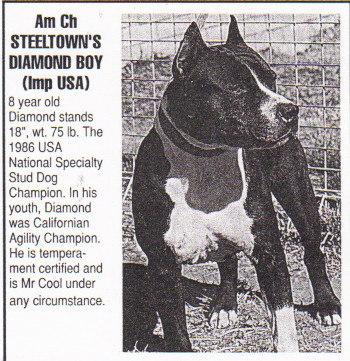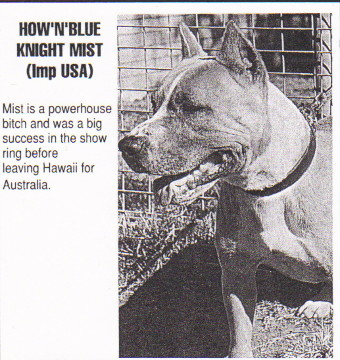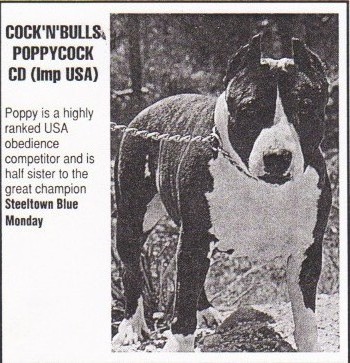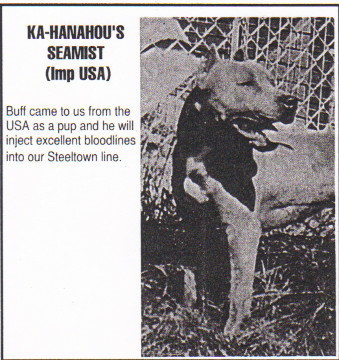|
BREED HISTORY & STANDARD |
|
|
AMSTAFF HISTORY
|
The American Staffordshire Terrier's roots date back to the early 19th century when dog fighting was popular. They originated in Staffordshire, England, through the crossing of a popular Terrier of the era and the Bulldog of that day. The desire was to combine the strength of the Bulldog and the tenacity of the Terrier. It is from the fighting Bulldog and Terrier that dedicated breeders produced a peaceable dog. When these dogs (the ancestors of the present day Amstaff) were first taken to USA, in the 1870's, they accompanied pioneer families and served as their pets and as guardians of the family and property. They were known as the American Terrier and as the Yankee Terrier. The breed was recognised by the AKC on June 10th 1936 as the Staffordshire Terrier. The name, however, was changed to American Staffordshire Terrier in 1972 to avoid confusion with the smaller cousin, the Staffordshire Bull Terrier. Although the Amstaff resembles the Pit bull, it is very much a separate, distinct breed. The Pit bull was specifically bred for fighting, and its only common link with the Amstaff is its ancestry. The AKC to this day does not recognise the Pit bull Terrier. Solid and athletic, the breed combines power, grace and agility. Bright, alert and courageous, the Amstaff is very good with children, and makes a fine housedog. But, because of his terrier nature, early obedience training is advised. A proper Amstaff personality and temperament is one of a loving and loyal family pet. They make an excellent guardian of property and family, and possess the ability to discriminate between strangers who mean them harm and those who do not. They have a wonderful sense of humour. The Amstaff is highly intelligent, and as such, needs an owner who is knowledgeable about animal behaviour, a basic background in obedience training and an understanding of Terrier traits and personality. They do very well in obedience and make a wonderful companion and friend. They are not a breed for everyone and generally not a good choice for the first-time dog owner. As in any breed of dog, or race of people, there are good and bad individuals. It is unreasonable to make a generalization that ALL within a breed, or race, are bad, based only on those few "bad individuals". For the last 50 years, Amstaff breeders have worked to breed the aggressiveness out and have strived to create a gentle, loving companion. To do so they have bred to a written show standard, which was established in 1935.
The American Staffordshire Terrier was officially recognised in Australia on 1st January 1987. The first Amstaff was imported from Hawaii in November 1985 by Mr & Mrs Murdoch of Red Cliffs Victoria. They were to become the first breeders/exhibitors of the breed, their kennel prefix being "Amstaff". The basis of their future breeding programme was to start with this import, "Rockislands O’Omua O Hawaii". Bob & Ruth's next import was the lovely brindle dog Ka Hanahou’s Lei O' Makana. He was to become the first Australian Champion, and with the earlier imported bitch was to produce the first Australian bred litter. In 1989, in Queensland, Dr Glucina of the "Araganu" prefix began to import Amstaffs into Australia. Over a period of time he imported the American Champion dog (Pictured Below) "Steeltowns Diamond Boy", another dog "Ka Hanahou’s Seamist", a bitch "Cock N Bulls Poppycock" and another bitch Haw N Blue Knight Mist. All having cropped ears, so unfortunately were unable to be shown in Australia. From these imports Dr Glucina was to start his breeding programme and produced his first litter in 1990. Some old clippings of Dr.Glucina's early Imports into Australia.
The Murdoch's next import was another male "Ka Hanahou’s Rojo’s Sam", a red dog. He was 8 ½ months old when released from quarantine on February 14th 1991. In
October 1990 Mark & Wendy Evans, of Evastaff Kennels in Tasmania, were to
purchase a brindle bitch from Hawaii. This was "Kalokos Lea", just 13
months old at time of purchase. She arrived in quarantine December 1990
and was released 12th April 1991. This bitch started her show career in August
the same year and went through to her Australian title. Kalokos Lea was the
first bitch to produce a litter with both parents being Australian Champions. In the following years imported semen produced some worthy Amstaff litters. Lee Jenkins, of Bluesteel Kennel in Victoria, imported semen from two dogs. International Ch Willynwood Redneck and American Ch Rowdytowns Hardrock Café. In Queensland Greg Gordon imported frozen semen from Am Ch Pacific's Distant Thunder. And later, in partnership with Lynda Craw (Lyntiki), the lovely blue dog "Am Ch Pacific's Hot Pursuit", who was co-owned by Greg and Lynda. Lynda Craw also imported two Amstaffs from New Zealand in 1998, (originally imported from Hawaii into NZ). The dog, "Aust/NZ Ch Kupa’a Tama of Triskara" and the bitch "Triskara Mea Kau Ake (AI USA)". The bitch arrived in whelp. Other breeders are investigating importing worthy dogs and bitches as well as further importation of frozen semen from good American bred dogs. Interest in the Amstaff within Australia is steadily on the increase. This versatile breed can be utilised as a family companion, a show dog and as an obedience dog. The breed is continually creating interest in and out of the show ring, and this, combined with a responsible breeding programme will enure a steady development of the America Staffordshire Terrier in Australia.
GENERAL IMPRESSION: The American Staffordshire Terrier should give the impression of great strength for his size, a well put-together dog, muscular, but agile and graceful. He should be stocky, not long-legged or racy in outline. CHARACTERISTICS: (Not specified) TEMPERAMENT: Keenly alive to his surroundings. His courage is proverbial. HEAD AND SKULL: Head medium length, deep through, broad skull, very pronounced cheek muscles, distinct stop. Muzzle medium length, rounded on upper side to fall away below eyes. Jaws well defined. Underjaw to be strong and have biting power. Lips close and even, no looseness. Nose definitely black. Dudley nose undesirable. EYES: Dark and round, low down in skull and set far apart. Light or pink eyes undesirable. No pink eyelids. EARS: Set high. Ears should be short and held rose or half pricked. Full drop to be penalized. MOUTH: Upper teeth to meet tightly outside lower teeth in front . Undershot or overshot mouths undesirable. NECK: Heavy, slightly arched, tapering from shoulders to back of skull. No looseness of skin. Medium length. FOREQUARTERS: Shoulders Strong and muscular with blades wide and sloping. The front legs should be straight, large or round bones, pastern upright. No resemblance of bend in front. Forelegs set rather wide apart to permit chest development. BODY: Back fairly short. Slight sloping from withers to rump with gentle short slope at rump to base of tail. Well-sprung ribs, deep in rear. All ribs close together. Chest deep and broad. Loins slightly tucked. HINDQUARTERS: Well-muscled, let down at hocks, turning neither in nor out. FEET: Feet of moderate size, well-arched and compact. TAIL: Short in comparison to size, low set, tapering to a fine point; not curled or held over back. Not docked. Tail too long or badly carried undesirable. GAIT/MOVEMENT: Must be springy but without roll or pace. COAT: Short, close, stiff to touch and glossy. COLOUR: Any colour, solid, parti, or patched is permissible, but all white, more than 80% white, black and tan, and liver not to be encouraged. SIZE: Height and weight should be in proportion. Height: Males about 18 to 19 inches at shoulders.Bitches: 17 to 18 inches at shoulder is considered preferable. FAULTS: Any departure from the forgoing points should be considered a fault and the seriousness with which the faults should be regarded should be in exact proportion to it's degree. NOTE: Male animals should have two apparently normal testicles fully descended into the scrotum. |





